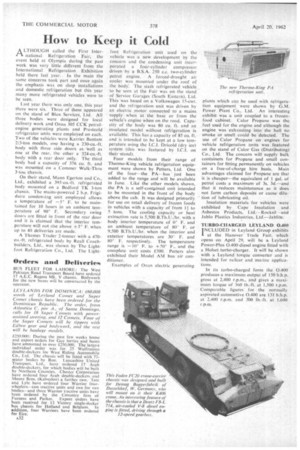How to Keep it Cold
Page 34

If you've noticed an error in this article please click here to report it so we can fix it.
PAA LTHOUGH called the First International Refrigeration Fair, the event held at Olympia during the past week was very little different from the International Refrigeration Exhibition held there last year. In the main the same concerns took part and once again the emphasis was on shop installations and domestic refrigeration but this year many more refrigerated vehicles were to be seen.
Last year there was only one, this year there were six. Three of these appeared on the stand of Blox.Services, Ltd. All three bodies were designed for local delivery work and Onan 305 CCK petrolengine generating plants and Prestcold refrigerator units were employed on each. Two of the vehicles were Karrier Bantam 2/3-ton models, one having a 230-cu.-ft. body with three side doors as Well as one at the rear, the other a 324-cu.-ft. body with a rear door only. The third body had a capacity of 376 cu. ft. and was mounted on a Commer Walk-Thru 3-ton chassis.
On their stand, Mann Egerton and Co.. Ltd., exhibited a 395-cu.-ft. refrigerated body mounted on a Bedford TK 3-ton chassis. The mains-powered 2 h.p. Frigidaire condensing unit employed allows a temperature of —5° F. to be maintained for 10 hours in an ambient temperature of 90° F. Secondary swing doors are fitted in front of the rear door and it is claimed that the interior temperature will not rise above +5° F. when up to 40 deliveries are made.
A Thames Trader 2-tonner with a 470cu,-ft. refrigerated body by Reall Coachbuilders. Ltd.. was shown by The Lightfoot Refrigeration Co., Ltd. The Light foot Refrigeration unit used on the vehicle was a new development by the concern and the condensing unit incorporated a four-cylinder compressor driven by a B.S.A. 250 c.c. two-cylinder petrol engine. A forced-draught air cooler was mounted under the roof of the body. The sixth refrigerated vehicle to be seen at the Fair was on the stand of Service Garages (South Eastern), Ltd. This was based on a Volkswagen 15-cwt. and the refrigeration unit was driven by an electric motor connected to a mains supply when at the base or from the vehicle's engine when on the road. Capacity of the body was 80 cu. ft. and an insulated model without refrigeration is available. This has a capacity of 85 cu. ft. and is intended to be kept at a low temperature using the I.C.I. Dricold (dry ice) system (this was featured by 1.CA, on their .stand).
Four models from their range of Thermo-King vehicle refrigeration equipment were shown by Petters, Ltd. One of the four—the PA—has just been added to the range and will be available in June. . Like the other models shown. the PA is a self-contained unit intended to be mounted in the front of the body above the cab. It was designed primarily for use on retail delivery of frozen foods in vehicles with a capacity of from 11 to 5 tons. The cooling capacity or heat extraction rate is 5,500 B.Th.U./hr. with a body interior temperature of 0° F. and an ambient temperature of 80° F. or 9,500 B.Th.U.Ihr. when the interior and exterior temperatures are 30° F. and 80° F. respectively. The temperature range is —10° F. to +50° F.. and the complete unit costs £500. Petters also exhibited their Model AM bus air conditioner.
Examples of Onan electric generating plants which can be used with refrigeration equipment were shown by G.M. Power Plant Co., Ltd. An interesting exhibit was a unit coupled to a frozenfood cabinet. Calor Propane was the fuel used for the engine and although the engine was exhausting into the hall no smoke or smell could be detected. The use of Calor Propane on engines for vehicle refrigeration units was featured on the stand of Calor Gas (Distributing) Co., Ltd. The concern will supply bulk containers for Propane and small containers for fitting permanently on vehicles • on a free-of-charge hire basis. Main advantages claimed for Propane are that it. is cheaper—the equivalent of 1 gal. of petrol costs a maximum of 3s. 3d.—and that it reduces maintenance as it does not form carbon deposits or cause dilution of lubricating oil.
Insulation materials for vehicles were exhibited by Cape Insulation and Asbestos Products, Ltd.—Rocksil —and Jablo Plastics Industries, Ltd.—Jablite.
TURBO-CHARGED LEYLAND 0.400 INCLUDED in Leyland Group exhibits i at the Hanover Trade Fair, which opens on April 29, will be a. Leyland Power-Plus 0.400 diesel engine fitted with a Holset turbo-charger. It will be shown with a Leyland torque converter and is intended for railcar and marine applications.
In its turbo-charged form the 0.400 produces a maximum output of 150 b.h.p. gross at 2.400 r.p.m., and gives a maximum torque of 360 lb.-ft. at 1,500 r.p.m. Comparable figuresfor the normally aspirated automotive 0.400 are 131 b.h.p. at 2.400 r.p.m. and 300 lb.-ft. at 1.600 r.p.m.
















































































































